Species
Published:
Published:
Published:
Published in , 2017
Reconstructable example for create sub labels like Gene Ontology graph with Ggplot

Published in , 2017
Find on rogerleite GitHub; Very nice work !

Published in , 2017
In R, ggplot2 requires data in a specific format. So, if you want to create a box plot with ggplot2 from a table, you must reshape it.

Published in Vieira thesis 2015, 2015
The brown alga Lobophora represents a major benthic component in tropical coral reefs, capable of dominating large reef areas following coral motality and herbivory declines. The alga, however, has been the object of contradictory observations in terms of susceptibility to herbivory. Unaware of the species-richness of this genus, virtually all the previous studies referred to the single Caribbean species referred to as Lobophora variegata, which was presumably polymorphic, with different chemical compositions and occupying diverse ecological niches. Variation in susceptibility of this single algal species to herbivory have been consequently interpreted as intraspecific variation in terms of morphology and chemical composition as well as differences in herbivore guild compositions and diet across different locations (e.g. habitat, reef, region). Recent taxonomical studies of the genus Lobophora disclosed a high species diversity, which could conceivably explain previous contradictory results. However, the present study, which compared the susceptibility to herbivory of eight different species of Lobophora, which differed in growth form as well as their fine-scale alpha-niche on coral reefs in the southern lagoon in New Caledonia, showed that they were all consumed without outstanding differences. These results suggest that Lobophora strategies in forms of escapes – associational or spatial – have been privileged by this brown tropical alga over defenses – chemical or morphological – against herbivores. Why fight if you can run? Strategies of the brown algal genus Lobophora (Dictyotales, Phaeophyceae) against herbivores. Available from: https://www.researchgate.net/publication/316442155_Why_fight_if_you_can_run_Strategies_of_the_brown_algal_genus_Lobophora_Dictyotales_Phaeophyceae_against_herbivores [accessed Apr 24, 2017].
Recommended citation: Vieira, C., Stenger, PL., Moleana, T., De Clerck, O., & Payri, C. (2015) - working paper - from Vieira Thesis 2015 https://www.researchgate.net/publication/316442155_Why_fight_if_you_can_run_Strategies_of_the_brown_algal_genus_Lobophora_Dictyotales_Phaeophyceae_against_herbivores
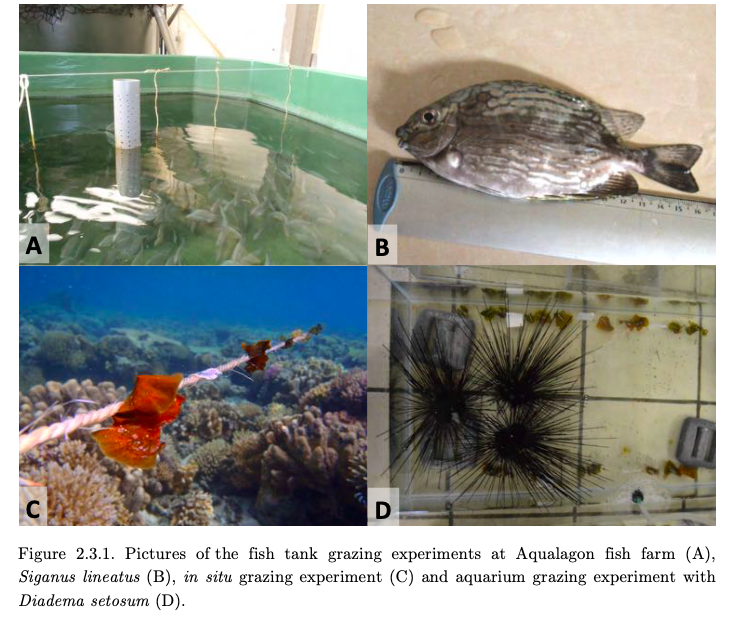
Published in Elsevier, 2015
Photo-Identification Catalogue 2015 Commerson dolphins of the Kerguelens islands.
Recommended citation: Vieira, C., Stenger, PL., Moleana, T., De Clerck, O., & Payri, C. (2015) - working paper - from Vieira Thesis 2015 https://www.researchgate.net/publication/316441989_Catalog_of_Commerson_dolphions_of_the_Kerguelen_islands
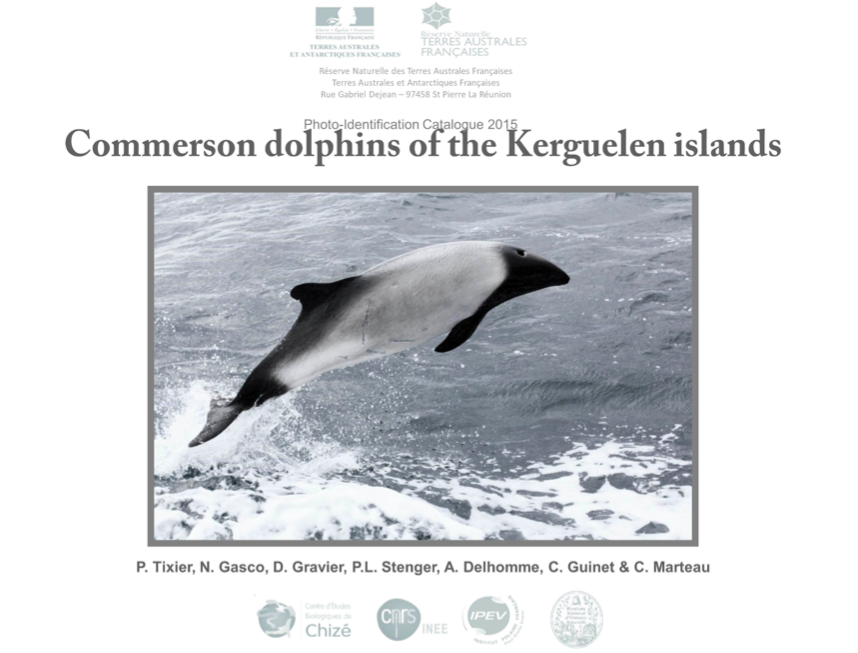
Published in Comparative Biochemistry and Physiology, 2017
Evaluating diffuse sediment contamination in the environment is a major concern with the aim of reaching a good chemical and ecological state of the littoral zone. In this study the risks of chronic chemical contamination and consequences in the bivalves Crassostrea gigas, Mytilus sp. and Mimachlamys varia were evaluated in coastal environments. The objective here was to understand the anthropological phenomena that affect the functioning of themarina of La Rochelle (semi-closed environment). Harbours seeking ecomanagement accreditations (such as the international reference ISO 14001) constitute zones of interest to implement biomonitoring studies. The biological effects of chemical pollution in the Marina of La Rochelle were studied to develop a multi-biomarker biomonitoring approach on specific marine species of this site. Moreover, a genetic (DNA barcoding) approach was applied to validate the species identity of collected bivalves. Of the three species tested the scallop, M. varia, was the most sensitive to metal exposure.
Recommended citation: Breitwieser, M., Viricel, A., Churlaud, C., Guillot, B., Martin, E., Stenger, P. L., ... & Thomas-Guyon, H. (2017). "First data on three bivalve species exposed to an intra-harbour polymetallic contamination (La Rochelle, France)." Comparative Biochemistry and Physiology Part C: Toxicology & Pharmacology.. http://ac.els-cdn.com/S1532045617300467/1-s2.0-S1532045617300467-main.pdf?_tid=95d450da-2944-11e7-8f90-00000aacb362&acdnat=1493076200_7fb6e69e9b1793f17049dc23dae9817d
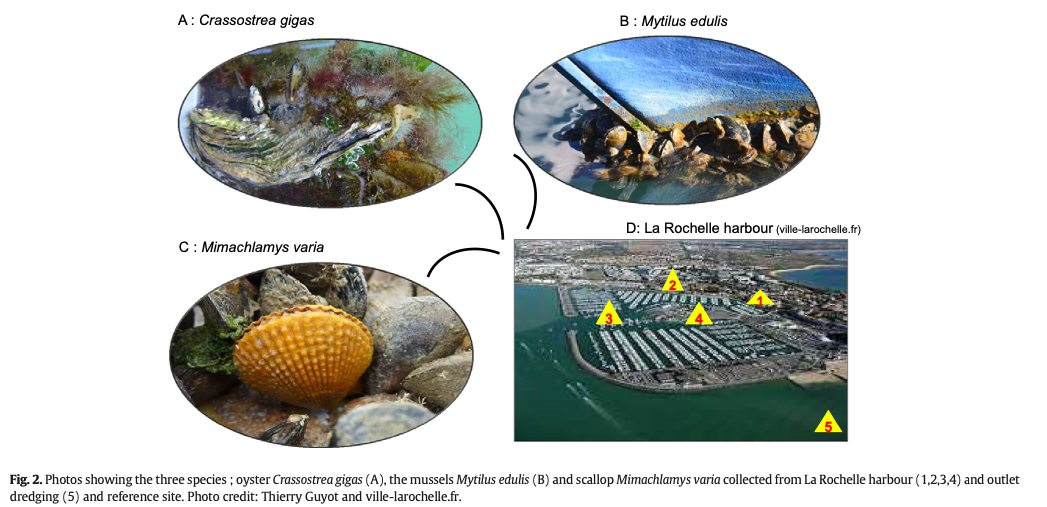
Published in CRAN, 2017
The pearl oyster, Pinctada margaritifera (Linnaeus, 1758), is one of the only bivalves expressing a large varied range of inner shell color, and by correlation, of pearl color. This phenotypic variability is partly under genetic control, but also under environmental influence. This R package allow to to delimit and characterize their color variations (by the HSV color system) with pictures.
Recommended citation: Stenger, P. L. (2017). "Package R ImaginR: Delimit and Characterize Color Phenotype of the Pearl Oyster" CRAN. https://cran.r-project.org/web/packages/ImaginR/ImaginR.pdf
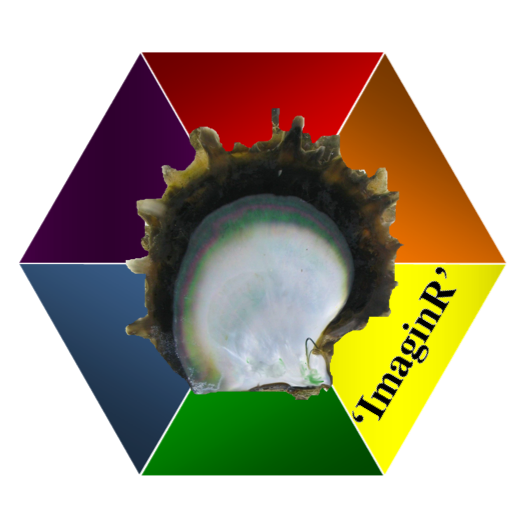
Published in Scientific Reports, 2019
The bivalve Pinctada margaritifera has the capacity to produce the most varied and colourful pearls in the world. Colour expression in the inner shell is under combined genetic and environmental control and is correlated with the colour of pearls produced when the same individual is used as a graft donor. One major limitation when studying colour phenotypes is grader subjectivity, which leads to inconsistent colour qualification and quantification. Through the use of HSV (Hue Saturation Value) colour space, we created an R package named ‘ImaginR’ to characterise inner shell colour variations in P. margaritifera. Using a machine-learning protocol with a training dataset, ‘ImaginR’ was able to reassign individual oysters and pearls to predefined human-based phenotype categories. We then tested the package on samples obtained in an experiment testing the effects of donor conditioning depth on the colour of the donor inner shell and colour of the pearls harvested from recipients following grafting and 20 months of culture in situ. These analyses successfully detected donor shell colour modifications due to depth- related plasticity and the maintenance of these modifications through to the harvested pearls. Besides its potential interest for standardization in the pearl industry, this new method is relevant to other research projects using biological models.
Recommended citation: Stenger, P. L., Vidal-Dupiol, J., Reisser, C., Planes, S., & Ky, C. L. (2019). "Colour plasticity in the shells and pearls of animal graft model Pinctada margaritifera assessed by HSV colour quantification." Scientific reports, 9(1), 1-10.. https://www.nature.com/articles/s41598-019-43777-4
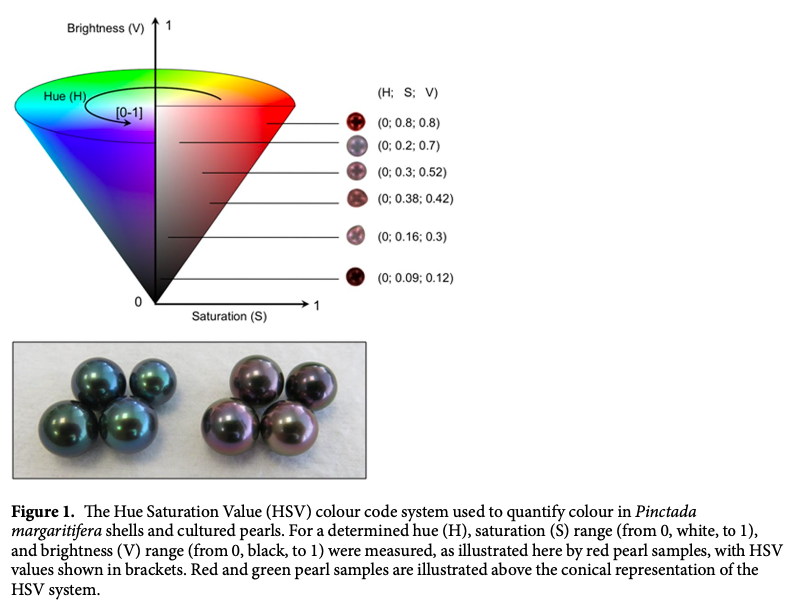
Published in Journal of Experimental Marine Biology and Ecology, 2019
The genus Lobophora is a notable benthic algal component of tropical coral reefs, capable of dominating large reef areas following coral mortality and herbivory declines. The alga, however, has been the object of contradictory observations in terms of susceptibility to herbivory. Unaware of the species-richness of this genus, most studies referred to Lobophora variegata, a species assumed to present various morphotypes and chemotypes, occupying diverse ecological niches. Variation in susceptibility to herbivory has been consequently interpreted as intraspecific variation in terms of morphology and chemical composition as well as differences in herbivore guild compositions and diet across different locations (e.g., habitat, reef, region). Recent taxonomic studies of Lobophora disclosed a high species diversity, which could explain previous conflicting observations. The present study tested the grazing susceptibility of seven species of Lobophora (L. dimorpha, L. hederacea, L. monticola, L. obscura, L. rosacea, L. sonderi and L. undulata), which differ in growth form as well as in their chemical com- position and fine-scale ecological niche on coral reefs in the southern lagoon in New Caledonia, to two important herbivores in New Caledonia, the rabbitfish Siganus lineatus and the sea urchin Diadema setosum using tank, cage, and in situ experiments. All seven Lobophora species were markedly consumed in situ and by the two herbivores. Differences in consumption among the Lobophora species were small but statistically significant. Lobophora rosacea, characterized by a distinct secondary metabolome, was significantly more consumed by the two herbivores. Conversely, L. sonderi was always among the least consumed species. These results point to the possible role of chemical defense, and suggest that L. rosacea may produce less or different chemical deterrents than the other Lobophora species, and that L. sonderi may produce deterrents active over a wider range of herbivores. However, the limited interspecific differences in consumption point to the greater importance of associational and spatial refuges as defense strategies against herbivores over chemical or morphological defenses in the genus Lobophora.
Recommended citation: Vieira, C., Stenger, P. L., Moleana, T., De Clerck, O., & Payri, C. (2019). "Limited interspecific variation in grazing susceptibility of the brown alga Lobophora to herbivory." Journal of Experimental Marine Biology and Ecology, 518, 151175.. https://www.sciencedirect.com/science/article/pii/S0022098118304817?casa_token=t20tBBmPaGwAAAAA:TpiHJITggZFYMztyrQoqNT7KEjHsKIA_aw6GoZCNBFQf-LQ2huIuThXjxxLpBG_DKe7izvtTRMY
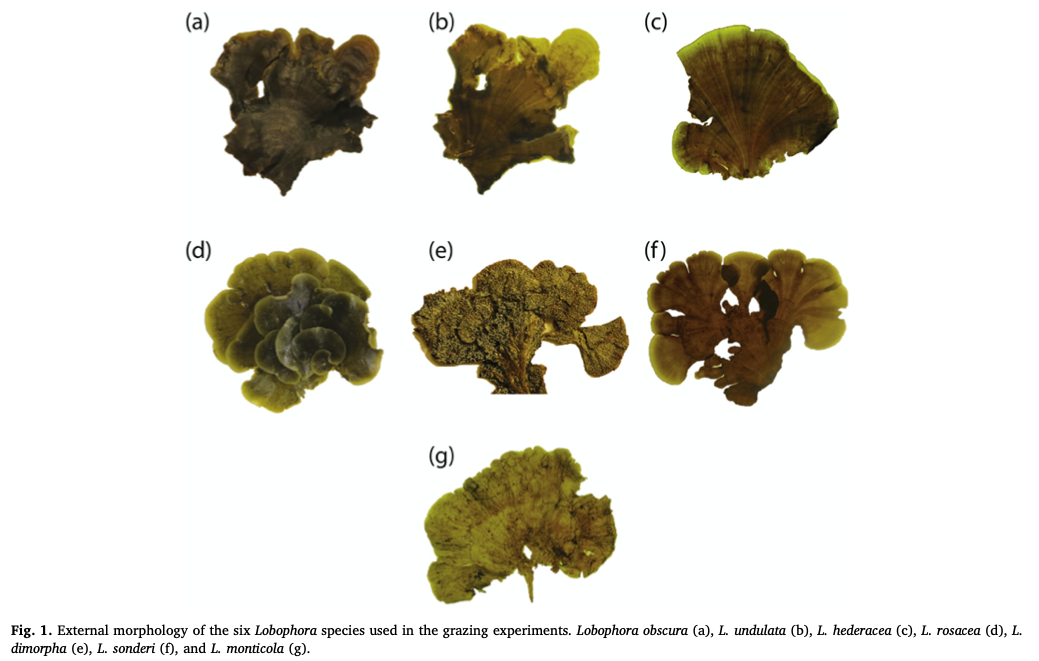
Published in BMC genomics, 2020
As a major threat to the oyster industry, Pacific Oyster Mortality Syndrome (POMS) is a polymicrobial disease affecting the main oyster species farmed across the world. POMS affects oyster juveniles and became panzootic this last decade, but POMS resistance in some oyster genotypes has emerged. While we know some genetic loci associated with resistance, the underlying mechanisms remained uncharacterized. So, we developed a comparative transcriptomic approach using basal gene expression profiles between different oyster biparental families with contrasted phenotypes when confronted to POMS (resistant or susceptible). We showed that POMS resistant oysters show differential expression of genes involved in stress responses, protein modifications, maintenance of DNA integrity and repair, and immune and antiviral pathways. We found similarities and clear differences among different molecular pathways in the different resistant families. These results suggest that the resistance process is polygenic and partially varies according to the oyster genotype. We found differences in basal expression levels of genes related to TLR-NFκB, JAK-STAT and STING-RLR pathways. These differences could explain the best antiviral response, as well as the robustness of resistant oysters when confronted to POMS. As some of these genes represent valuable candidates for selective breeding, we propose future studies should further examine their function.
Recommended citation: De Lorgeril, J., Petton, B., Lucasson, A., Perez, V., Stenger, P. L., Dégremont, L., ... & Leroy, M. (2020). "Differential basal expression of immune genes confers Crassostrea gigas resistance to Pacific oyster mortality syndrome." BMC genomics, 21(1), 1-14. https://bmcgenomics.biomedcentral.com/articles/10.1186/s12864-020-6471-x
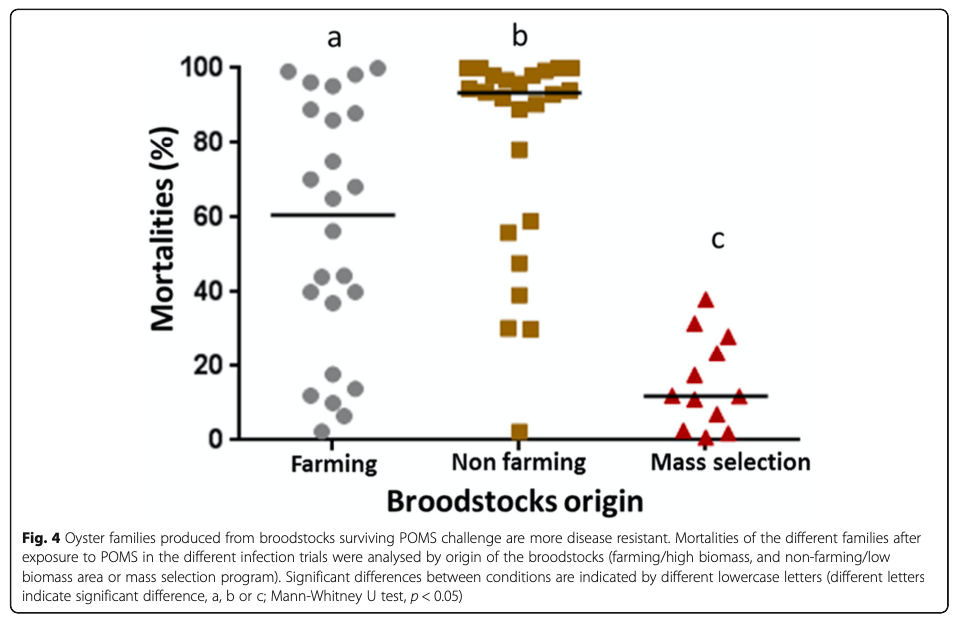
Published in Frontiers in microbiology, 2020
Juvenile Pacific oysters (Crassostrea gigas) are subjected to recurrent episodes of mass mortalities that constitute a threat for the oyster industry. This mortality syndrome named “Pacific Oyster Mortality Syndrome” (POMS) is a polymicrobial disease whose pathogenesis is initiated by a primary infection by a variant of an Ostreid herpes virus named OsHV-1 μVar. The characterization of the OsHV-1 genome during different disease outbreaks occurring in different geographic areas has revealed the existence of a genomic diversity for OsHV-1 μVar. However, the biological significance of this diversity is still poorly understood. To go further in understanding the consequences of OsHV-1 diversity on POMS, we challenged five biparental families of oysters to two different infectious environments on the French coasts (Atlantic and Mediterranean). We observed that the susceptibility to POMS can be different among families within the same environment but also for the same family between the two environments. Viral diversity analysis revealed that Atlantic and Mediterranean POMS are caused by two distinct viral populations. Moreover, we observed that different oyster families are infected by distinct viral populations within a same infectious environment. Altogether these results suggest that the co-evolutionary processes at play between OsHV-1 μVar and oyster populations have selected a viral diversity that could facilitate the infection process and the transmission in oyster populations. These new data must be taken into account in the development of novel selective breeding programs better adapted to the oyster culture environment.
Recommended citation: Delmotte J, Chaparro C, Galinier R, de Lorgeril J, Petton B, Stenger P-L, Vidal-Dupiol J, Destoumieux-Garzon D, Gueguen Y, Montagnani C, Escoubas J-M and Mitta G (2020) Contribution of Viral Genomic Diversity to Oyster Susceptibility in the Pacific Oyster Mortality Syndrome." Front. Microbiol. 11:1579. doi: 10.3389/fmicb.2020.01579 https://www.frontiersin.org/articles/10.3389/fmicb.2020.01579/full?&utm_source=Email_to_authors_&utm_medium=Email&utm_content=T1_11.5e1_author&utm_campaign=Email_publication&field=&journalName=Frontiers_in_Microbiology&id=540521

Published in Genes, 2021
The shell color of the Mollusca has attracted naturalists and collectors for hundreds of years, while the molecular pathways regulating pigment production and the pigments themselves remain poorly described. In this study, our aim was to identify the main pigments and their molecular pathways in the pearl oyster Pinctada margaritifera —the species displaying the broadest range of colors. Three inner shell colors were investigated—red, yellow, and green. To maximize phenotypic homogeneity, a controlled population approach combined with common garden conditioning was used. Comparative analysis of transcriptomes (RNA-seq) of P. margaritifera with different shell colors revealed the central role of the heme pathway, which is involved in the production of red (uropor- phyrin and derivates), yellow (bilirubin), and green (biliverdin and cobalamin forms) pigments. In addition, the Raper–Mason, and purine metabolism pathways were shown to produce yellow pig- ments (pheomelanin and xanthine) and the black pigment eumelanin. The presence of these pigments in pigmented shell was validated by Raman spectroscopy. This method also highlighted that all the identified pathways and pigments are expressed ubiquitously and that the dominant color of the shell is due to the preferential expression of one pathway compared with another. These pathways could likely be extrapolated to many other organisms presenting broad chromatic variation.
Recommended citation: Stenger PL., Ky CL., Reisser C., Duboisset J., Dicko H., Durand P., Quintric L., Planes S., Vidal-Dupiol J. (2021) - Molecular pathways and pigments underlying the colors of the Pearl Oyster Pinctada margaritifera var. cumingii (Linnaeus 1758).- Genes, 12, 421. https:// doi.org/10.3390/genes12030421Front. https://www.mdpi.com/2073-4425/12/3/421
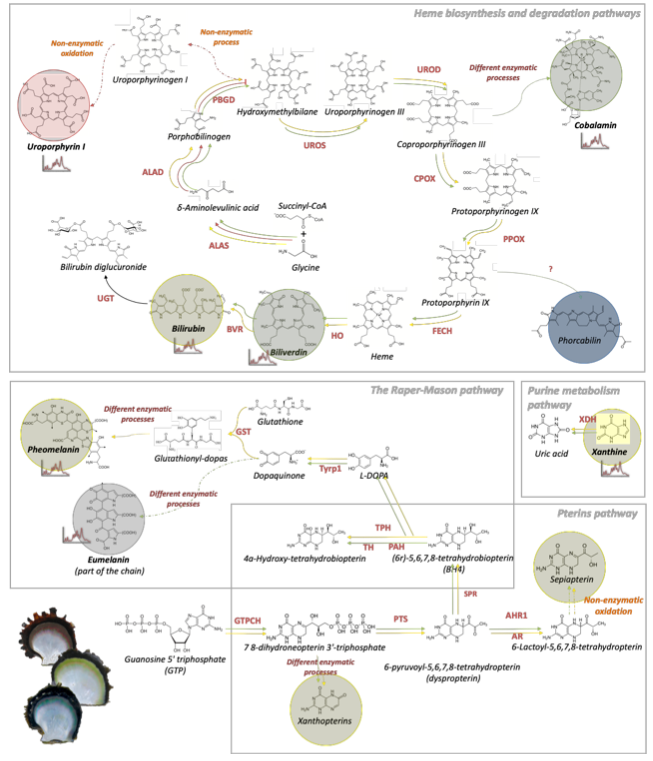
Published in Frontiers in Genetics, 2021
Today, it is common knowledge that environmental factors can change the color of many animals. Studies have shown that the molecular mechanisms underlying such modifications could involve epigenetic factors. Since 2013, the pearl oyster Pinctada margaritifera var. cumingii has become a biological model for questions on color expression and variation in Mollusca. A previous study reported color plasticity in response to water depth variation, specifically a general darkening of the nacre color at greater depth. However, the molecular mechanisms behind this plasticity are still unknown. In this paper, we investigate the possible implication of epigenetic factors controlling shell color variation through a depth variation experiment associated with a DNA methylation study performed at the whole genome level with a constant genetic background. Our results revealed six genes presenting differentially methylated CpGs in response to the environmental change, among which four are linked to pigmentation processes or regulations (GART, ABCC1, MAPKAP1, and GRL101), especially those leading to darker phenotypes. Interestingly, the genes perlucin and MGAT1, both involved in the biomineralization process (deposition of aragonite and calcite crystals), also showed differential methylation, suggesting that a possible difference in the physical/spatial organization of the crystals could cause darkening (iridescence or transparency modification of the biomineral). These findings are of great interest for the pearl production industry, since wholly black pearls and their opposite, the palest pearls, command a higher value on several markets. They also open the route of epigenetic improvement as a new means for pearl production improvement.
Recommended citation: Stenger P-L, Ky C-L, Reisser CMO, Cosseau C, Grunau C, Mege M, Planes S and Vidal-Dupiol J (2021) Environmentally Driven Color Variation in the Pearl Oyster *Pinctada margaritifera* var. *cumingii* (Linnaeus, 1758) Is Associated With Differential Methylation of CpGs in Pigment and Biomineralization-Related Genes. Front. Genet. 12:630290. doi: 10.3389/fgene.2021.630290 https://www.frontiersin.org/articles/10.3389/fgene.2021.630290/full
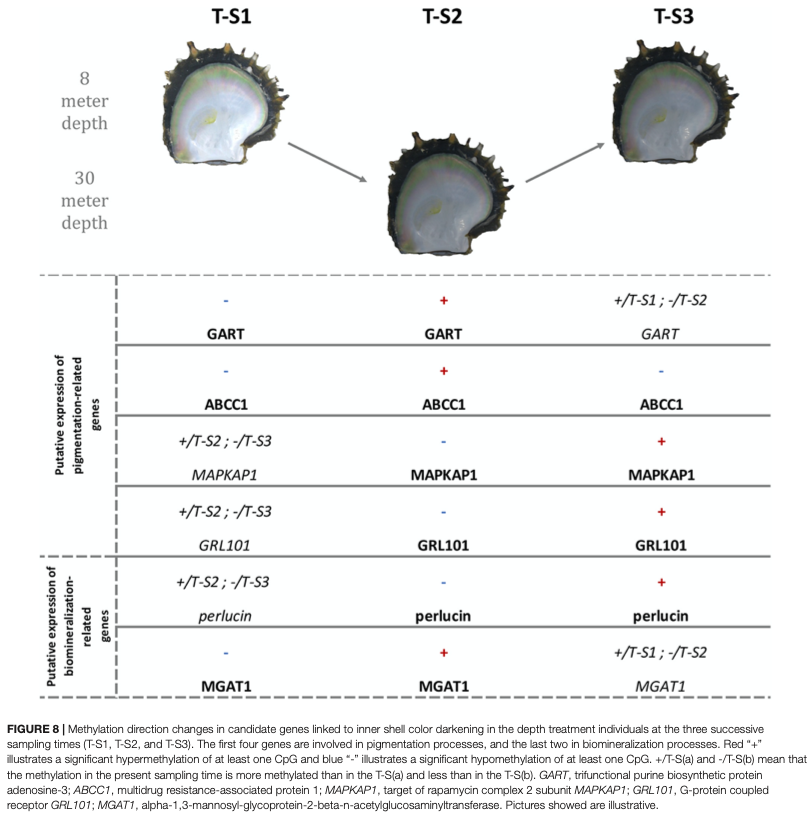
Published in Ecological Engineering, 2021
Due to their central role in ecosystems functioning and their ability to rapidly respond to environmental changes, soil microorganisms could potentially be used for monitoring ecosystems recovery in the context of degraded land restoration. However, these belowground organisms have been, to date, largely neglected. Here, we investigated fungal and bacterial community diversity, composition, and structure from ultramafic soils in New Caledonia, an archipelago in the southwest Pacific recognized as a priority for conservation and restoration. The emerging approach of high-throughput amplicon sequencing of environmental DNA (eDNA) – metabarcoding of eDNA – was used to compare soil microbial communities from four different native vegetation types, repre- senting different stages of a chronosequence and defined as reference ecosystems, to five distinct post-mining sites revegetated several years ago. Our results clearly revealed changes in soil microbial phyla and functional groups along the reference chronosequence and variable responses at the different revegetated sites, with two of the five sites showing a good trajectory of recovery. We thus propose three ratios as metrics for monitoring the restoration trajectory of soil microorganisms: the Ascomycota:Basidiomycota and Saprotrophic:Ectomycorrhizal ratios for fungi, and the Cyanobacteria:Chloroflexi ratios for bacteria. Our study, combined with recent works undertaken in other geographical areas, underpins the great promise that could represent soil microbial eDNA metabarcoding for monitoring restoration progress and success. With the emergence of these new cost-effective and scalable sequencing technologies, soil microbes could, in the near future, be included in guidelines for restoration operations in complement to more conventional approaches.
Recommended citation: Fernandez Nuñez N, Maggia L., Stenger PL., Lelievre M., Letellier K., Gigante S., Manez A., Mournet P., Ripoll J., Carriconde F. (2021) - Potential of high-throughput eDNA sequencing of soil fungi and bacteria for monitoring ecological restoration in ultramafic substrates: The case study of the New Caledonian biodiversity hotspot. – Ecological Engineering, 173, 106416. https://www.sciencedirect.com/science/article/pii/S0925857421002718
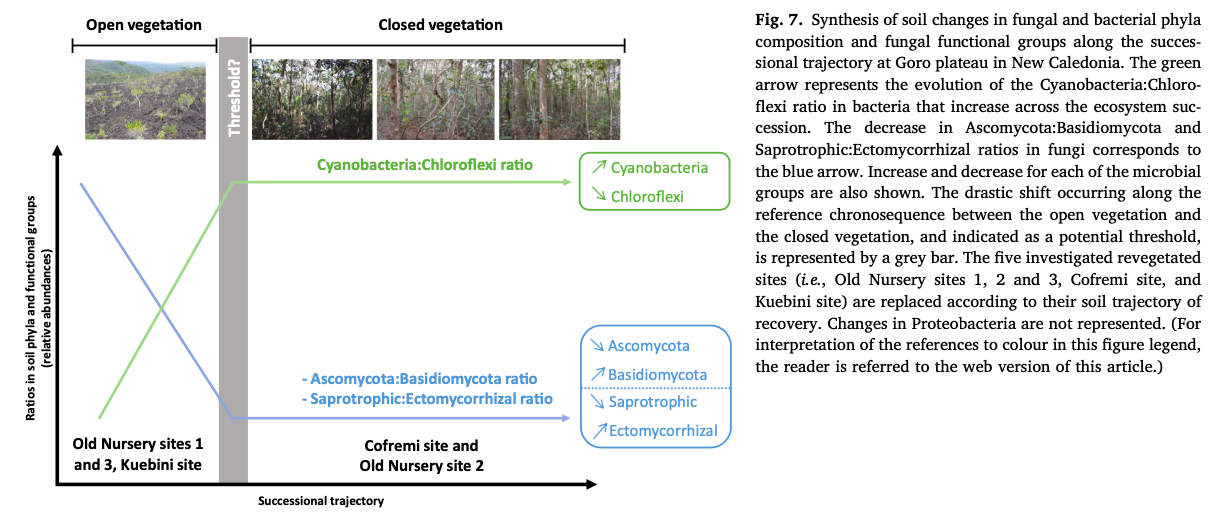
Published in Evolutionary Applications, 2022
For hundreds of years, the color diversity of Mollusca shells has been a topic of interest for humanity. However, the genetic control underlying color expression is still poorly understood in mollusks. The pearl oyster Pinctada margaritifera is increasingly becoming a biological model to study this process due to its ability to produce a large range of colors. Previous breeding experiments demonstrated that color phenotypes were partly under genetic control, and while a few genes were found in comparative transcriptomics and epigenetic experiments, genetic variants associated with the phenotypes have not yet been investigated. Here, we used a pooled-sequencing approach on 172 individuals to investigate color-associated variants on three color phenotypes of economic interest for pearl farming, in three wild and one hatchery populations. While our results uncovered SNPs targeting pigment-related genes already identified in previous studies, such as PBGD, tyrosinases, GST, or FECH, we also identified new color-related genes occurring in the same pathways, like CYP4F8, CYP3A4, and CYP2R1. Moreover, we identified new genes involved in novel pathways unknown to be involved in shell coloration for P. margaritifera, like the carotenoid pathway, BCO1. These findings are essential to possibly implement future breeding programs focused on individual selection for specific color production in pearl oysters and improve the footprint of perliculture on the Polynesian lagoon by producing less but with a better quality.
Recommended citation: Stenger PL., Ky CL., Vidal Dupiol J., Planes S., Reisser C. (2022) - Identifying genes associated with genetic control of color polymorphism in the pearl oyster Pinctada margaritifera var. cumingii (Linnaeus 1758) using a comparative whole genome pool-sequencing approach – Evolutionary Applications, https://doi.org/10.1111/eva.13464 https://onlinelibrary.wiley.com/doi/abs/10.1111/eva.13464
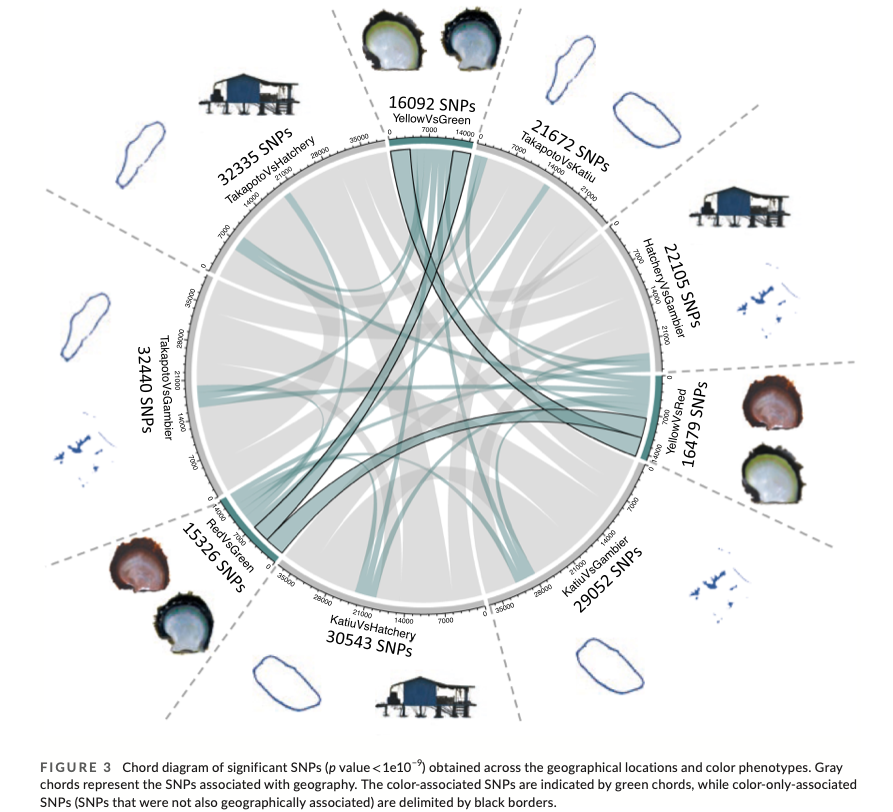
Published in CRAN, 2022
Targeted differential and global enrichment analysis of taxonomic rank by shared ASVs (Amplicon Sequence Variant), for high-throughput eDNA sequencing of fungi, bacteria, and metazoan.
Recommended citation: Stenger, P.-L. The R Package “Anaconda”: Targeted Differential and Global Enrichment Analysis of Taxonomic Rank by Shared Asvs 2022, CRAN 1–28. http://dx.doi.org/10.13140/RG.2.2.11117.67048. https://cran.r-project.org/web/packages/Anaconda/index.html
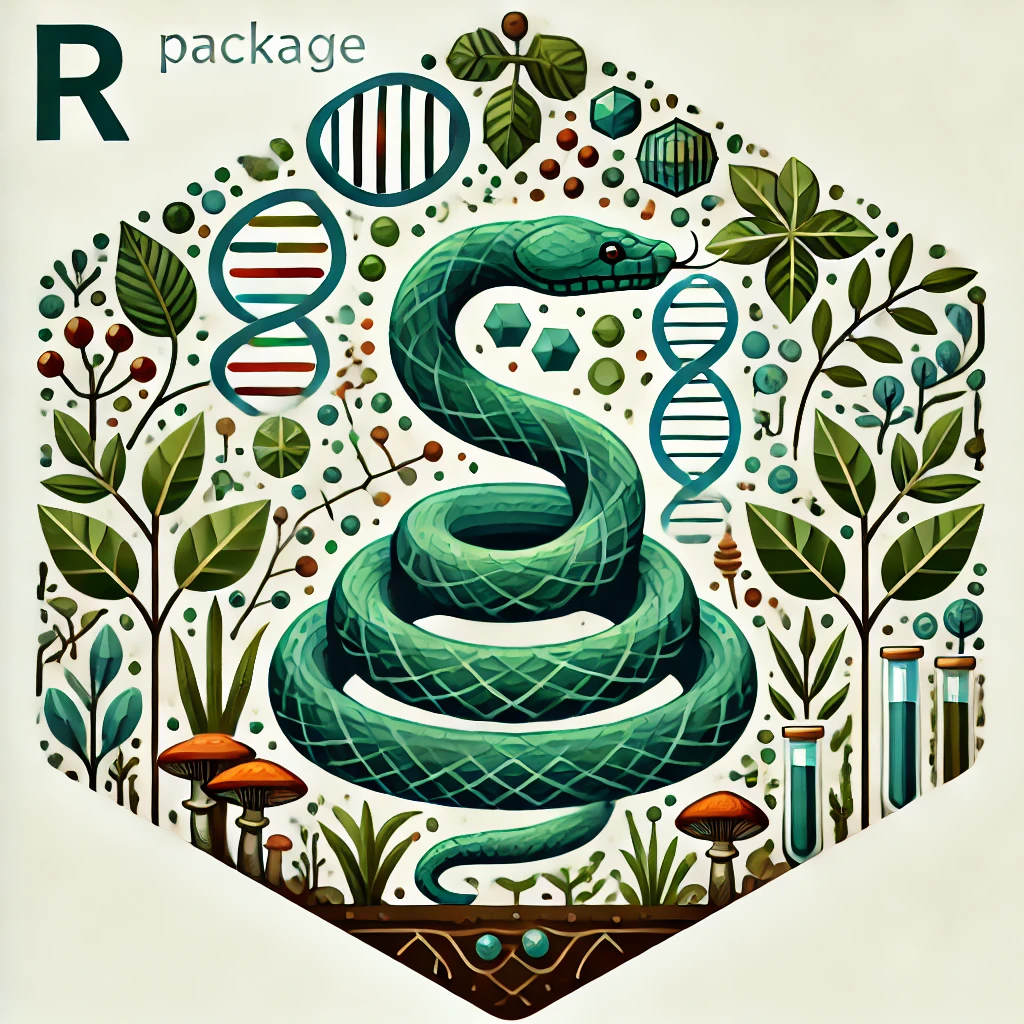
Published in Marine Ecology, 2023
The capacity of marine sponges to cope with environmental changes is often attributed to the specific composition of their bacterial communities. In this study, we assessed the bacterial microbiome of two dominant sponges, Rhabdastrella globostellata (Rg) and Hyrtios erectus (He), living in the Bouraké lagoon (New Caledonia), where abiotic conditions daily fluctuate according to the tide. Sponge specimens, sediment and seawater samples were collected at 2–3 m depth. The bacterial communities were assessed using 16S rRNA metabarcoding, and variations between the two sponges were compared using PCA biplots. Chloroflexi was the dominant phyla in both He and Rg with an average relative abundance of 41.2% and 53.2%, respectively, while it was absent in sediment and seawater. Among the phylum Chloroflexi, SAR202 clade was dominant in both sponges, reaching an average relative abundance of 53.2% (He) and 78.7% (Rg). Principal component analysis (PCA) was used to identify the main variables driving the bacterial community structure in both sponges. The results indicated that the bacterial community structure in both sponges was strongly associated with Chloroflexi (70.9% of the phyla variance) and SAR202 clade (86.6% of the clade vari- ance). The high relative abundance of the phylum Chloroflexi and the SAR202 clade observed in this study is the highest reported so far in the literature in marine sponges. Such a high relative abundance of these bacteria could suggest their involvement in the well-being of sponges in the extreme environmental conditions of Bouraké.
Recommended citation: Maggioni, F., Stenger, P. L., Jourand, P., & Majorel, C. (2023). The phylum Chloroflexi and their SAR 202 clade dominate the microbiome of two marine sponges living in extreme environmental conditions. Marine Ecology, 44(5), e12757, https://doi.org/10.1111/maec.12757. https://onlinelibrary.wiley.com/doi/full/10.1111/maec.12757
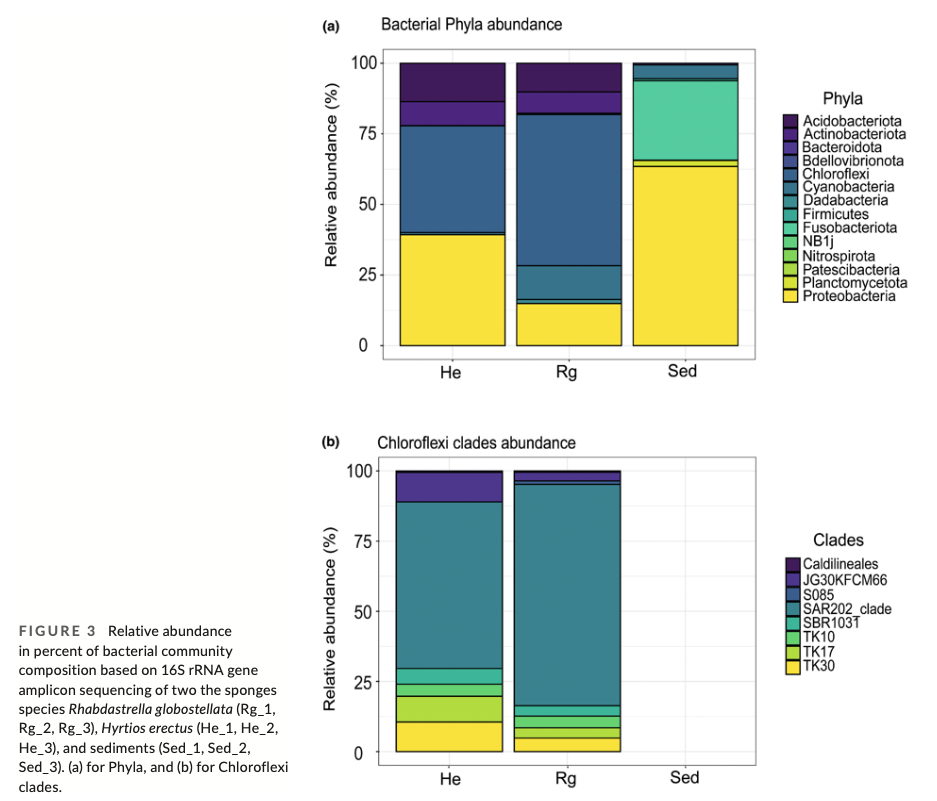
Published in Phytotaxa, 2023
a new foliicolous species from New Caledonia.
Recommended citation: Lebreton, E., Carriconde, F., Brouste, D., Lespagnol, A., Stenger, P. L., Sérusiaux, E., & Ertz, D. (2023). Enterographa ducouretiana sp. nov.(lichenized Ascomycota, Roccellaceae), a new foliicolous species from New Caledonia. Phytotaxa, 609(3), 247-252, https://doi.org/10.11646/phytotaxa.609.3.8 https://phytotaxa.mapress.com/pt/article/view/phytotaxa.609.3.8
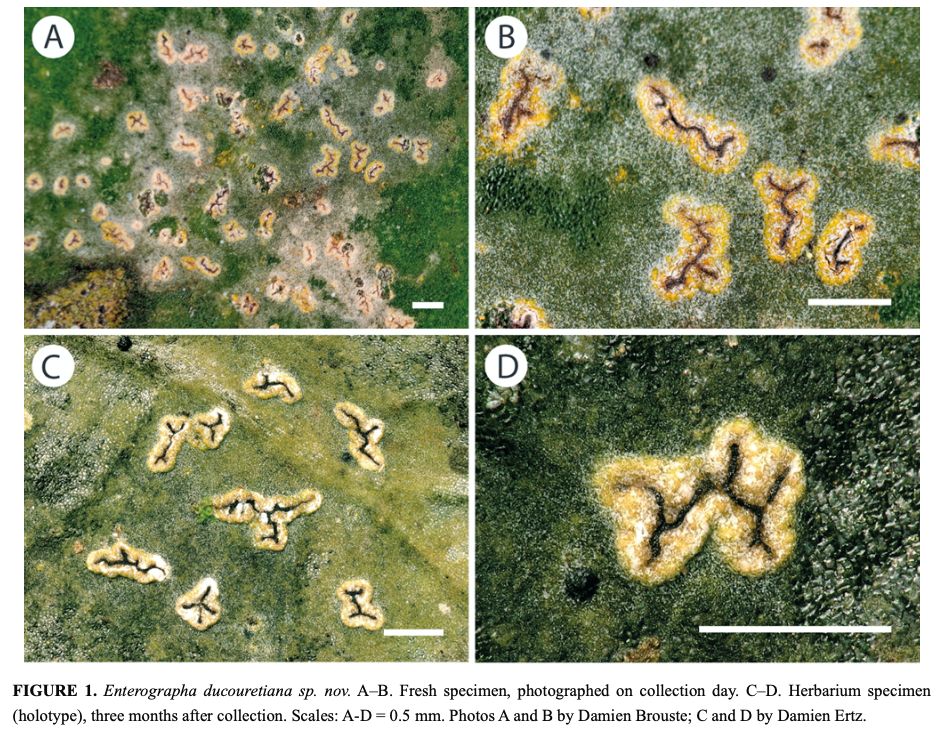
Published in Frontiers in Marine Science, 2023
The occurrence and seasonality of the Critically Endangered great hammerhead shark, Sphyrna mokarran, is data deficient in the Central Pacific region. Using photo-identification and laser-photogrammetry, we describe the seasonal population of great hammerhead sharks in the Tiputa pass (Rangiroa atoll) and Tuheiava pass (Tikehau atoll) in the Tuamotu archipelago of French Polynesia. During the austral summer of 2020 and 2021, we recorded a female-biased aggregation of at least 55 individuals (54 females; 1 unknown sex), representing an unprecedented number of S. mokarran in one study. All measured sharks were likely mature with pre-caudal lengths ranging from 147 cm to 297 cm (n = 35). Videos from citizen scientists recorded over a 15-year period enable us to identify 30 additional individuals between 2006 and 2019, with strong evidence of sexual segregation during the year. Our findings revealed seasonal residency (n = 32) of up to 6 days/month and for up to 5 months at the study site during the austral summer. We also demonstrated site fidelity with 32 individuals returning to the same atoll for up to 12 years between the first and last sighting, and with limited evidence of connectivity between the two sites. Our analysis also provides preliminary insight into the environmental factors driving S. mokarran aggregation in the Tiputa pass, suggesting a marked influence of the lunar cycle and of ocellated eagle rays (Aetobatus ocellatus) abundance. This study, conducted in situ with non-invasive methods offers a unique opportunity to study a great hammerhead shark population in a near-pristine ecosystem and provides important life-history elements for the Central Pacific region.
Recommended citation: Boube, T., Azam, C. S., Guilbert, A., Huveneers, C., Papastamatiou, Y. P., Mourier, J., ... & Stenger, P. L. (2023). First insights into the population characteristics and seasonal occurrence of the great hammerhead shark, Sphyrna mokarran (Rüppell, 1837) in the Western Tuamotu archipelago, French Polynesia. Frontiers in Marine Science, 10, 1234059, https://doi.org/10.3389/fmars.2023.1234059. https://www.frontiersin.org/journals/marine-science/articles/10.3389/fmars.2023.1234059/full
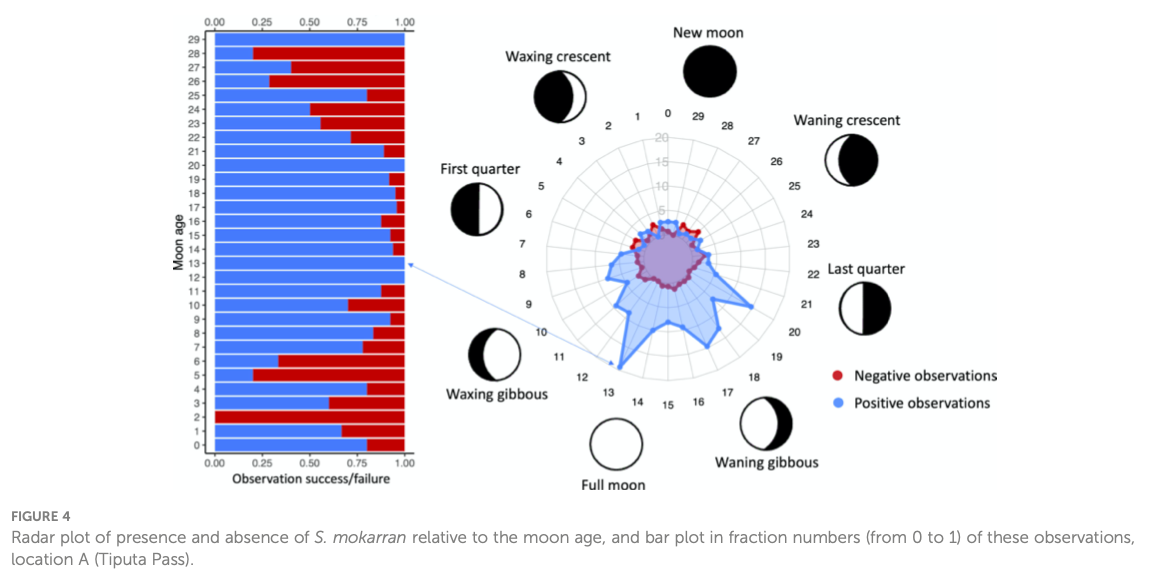
Published in Biometals, 2023
The ability of marine filter feeders to accumulate metals could help monitor the health of the marine environment. This study examined the concentration of metallic trace elements (MTE) in two marine sponges, Rhabdastrella globostellata and Hyrtios erectus, from three sampling zones of the semi-enclosed Bouraké Lagoon (New Caledonia, South West Pacific). MTE in sponge tissues, seawater, and surrounding sediments was measured using inductively coupled plasma with optical emission spectroscopy. The variability in sponge MTE concentrations between species and sampling zones was visually discriminated using a principal component analysis (PCA). Sponges showed Fe, Mn, Cr, Ni, and Zn concentrations 2 to 10 times higher than in the surrounding sediments and seawater. Hyrtios erectus accumulated 3 to 20 times more MTE than R. globostellata, except for Zn. Average bioconcentration factors in sponge tissues were (in decreasing order) Zn > Ni > Mn > Fe > Cr relate to sediments and Fe > Ni > Mn > Cr > Zn relate to seawater. The PCA confirmed higher MTE concentrations in H. erectus compared to R. globostellata. Our results confirm that marine sponges can accumulate MTE to some extent and could be used as a tool for assessing metals contamination in lagoon ecosystems, particularly in New Caledonia, where 40% of the lagoon is classified as a UNESCO World Heritage Site.
Recommended citation: Maggioni, F., Stenger, P. L., Letourneur, Y., Jourand, P., & Majorel, C. (2024). Metallic trace elements in marine sponges living in a semi-enclosed tropical lagoon. BioMetals, 37(1), 157-169, https://doi.org/10.1007/s10534-023- 00536-3 https://link.springer.com/article/10.1007/s10534-023-00536-3
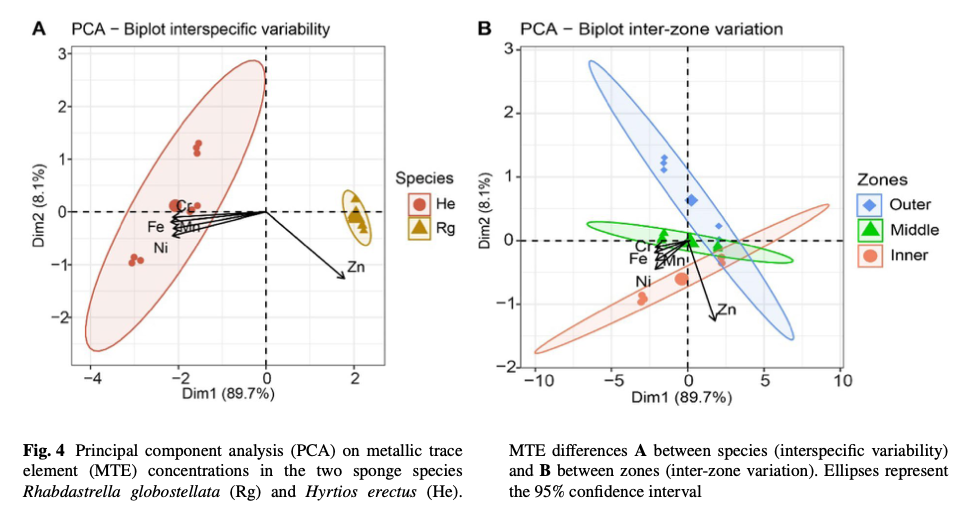
Published in Herpetology Notes, 2023
Monitor lizards of the genus Varanus face significant threats in the wild, with 74 of the 85 known species listed by the IUCN at various threat levels. Major threats to these lizards include habitat destruction, the global pet trade, human consumption, road mortality, and discarded items like food containers. Varanus salvator macromaculatus, a widely distributed semi-aquatic lizard in Southeast Asia, is currently listed as “Least Concern” by the IUCN. The study reports on field observations from Aceh Province, Sumatra, Indonesia, where water monitors are frequently caught using circular aquatic traps, which are primarily intended for crabs but also capture lizards. Local fishermen value the meat of these lizards, and they are widely consumed by the indigenous Nias people and traded for their leather in North Sumatra. The use of circular traps rather than conventional snare traps is a new finding for Aceh Province, highlighting additional threats to monitor lizards that have not been previously documented in the region. While monitor lizards are legally protected under Indonesian law, the hunting and trade of these animals raise concerns about the sustainability and legality of these practices, particularly in Sumatra. There is a need for updated research to assess the impact of these activities on monitor lizard populations, including the effects of novel trapping methods on non-target species and other herpetofauna. Addressing these concerns is crucial for informing conservation efforts and ensuring the sustainable use of monitor lizards, thereby preserving biodiversity and maintaining healthy ecosystems in the region.
Recommended citation: Zdunek, P., & Stenger, P. L. (2023). A dragon in a trap! A record of using an aquatic trap to collect the Southeast Asian Water Monitor, Varanus salvator macromaculatus (Deraniyagala, 1944), in Indonesia (Squamata: Varanidae). Herpetology Notes, 16, 937-940, https://hal.science/hal-04354803. https://hal.science/hal-04354803/document
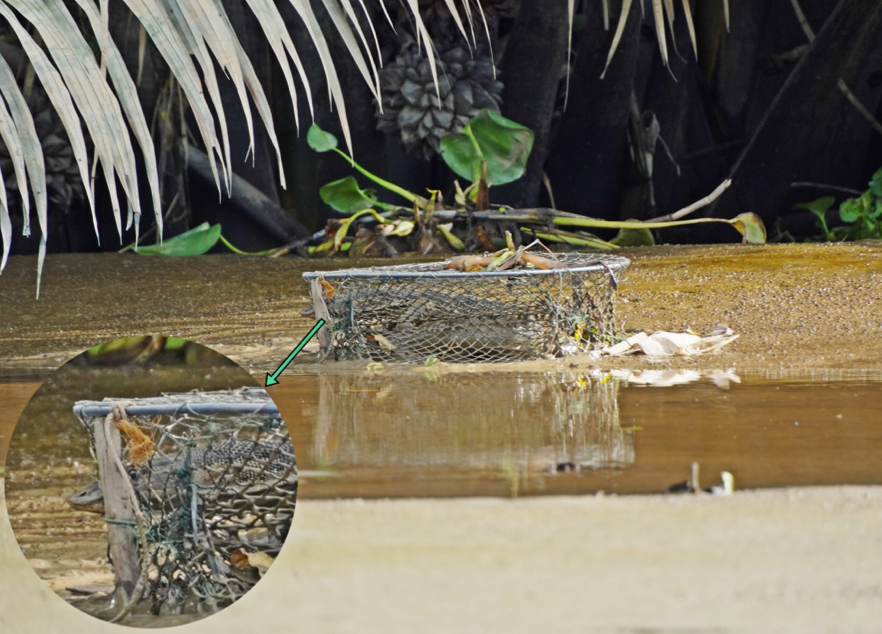
Published in Zootaxa, 2024
Caledargiolestes janiceae Lieftinck, 1975 was erected on the basis of a single not-fully mature male. Eleven years later a female was captured but never described. Despite further searching, this species was only rediscovered in early 2022 with one female and two males (immature and mature) collected. This paper provides descriptions of the female and of the male in different stages of maturity.
Recommended citation: Stenger PL., Mille C., J. Theuerkauf, Jourdan H., M. Marinov (2024). Description of the female and variation in males of the critically endangered Caledargiolestes janiceae Lieftinck, 1975 from South New Caledonia (Odonata: Zygoptera: Argiolestidae). Zootaxa, 5468(2), 379-392, https://doi.org/10.11646/zootaxa.5468.2.8 https://www.mapress.com/zt/article/view/zootaxa.5468.2.8
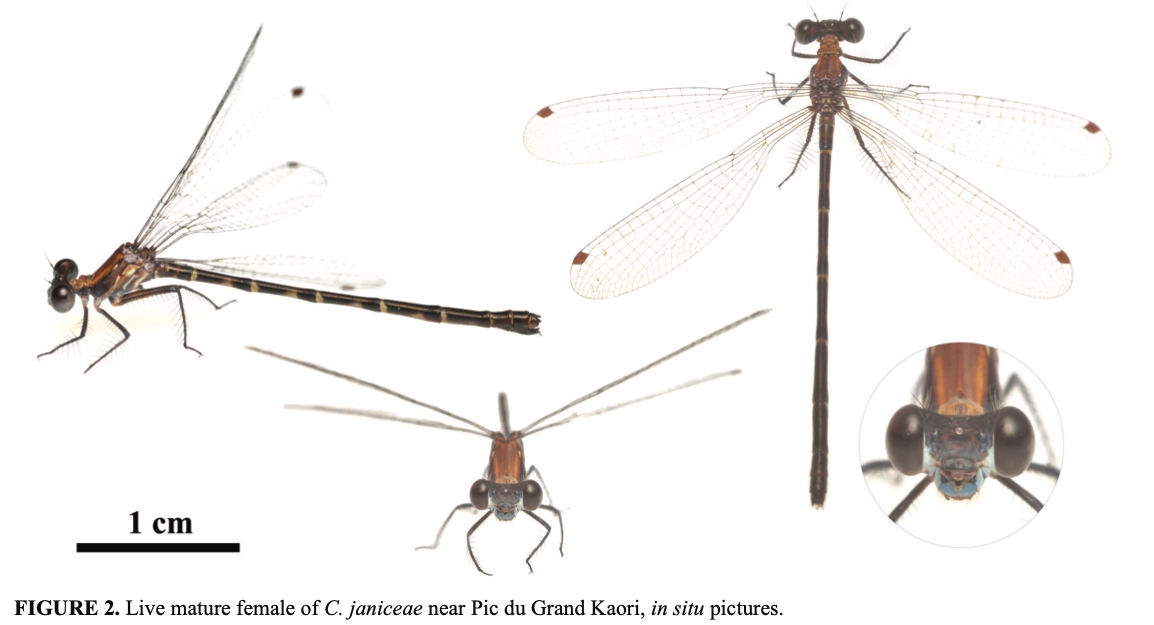
Published in Journal of Herpetology, 2024
This study explores the spatial ecology and social structure of Lacertoides pardalis, a vulnerable skink species endemic to New Caledonia’s ultramafic maquis shrublands. Using radiotelemetry, we reveal home range dynamics, habitat preferences, and intraspecific interactions, providing crucial insights for conservation efforts.
Recommended citation: Deuss M., Bousseyroux A., Stenger P.-L., Jourdan H. (2024). Social Structure and Habitat Use of New Caledonian Leopard Skinks (Scincidae: Lacertoides pardalis): A Radiotelemetric Study. Journal of Herpetology, 148–161, https://doi.org/10.1670/22-069 https://doi.org/10.1670/22-069
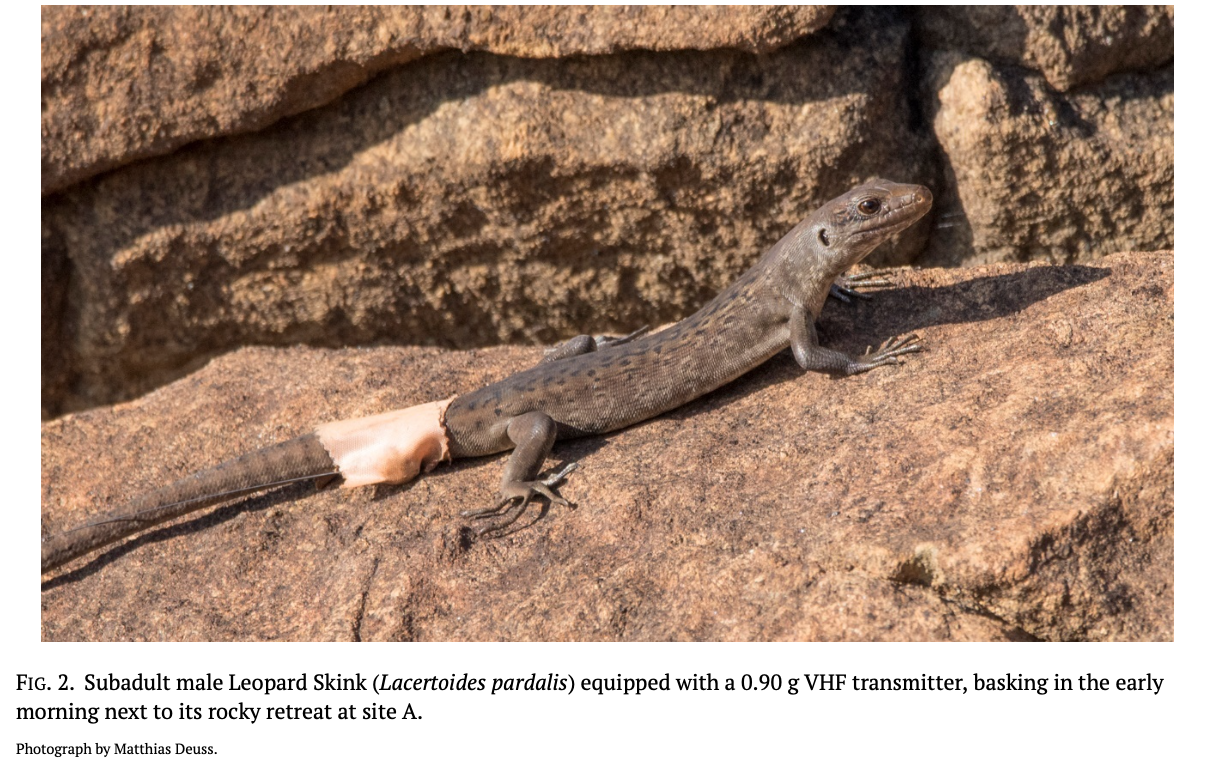
Published in Current Research in Environmental & Applied Mycology (Journal of Fungal Biology), 2024
This study investigates the infection of Carcinopsis sp. wētā by entomopathogenic fungi in the Dogny Forest, New Caledonia. Molecular analyses reveal the presence of Beauveria malawiensis and Trichoderma uncinatum, shedding light on their ecological interactions and implications for biodiversity conservation in forest ecosystems.
Recommended citation: Stenger PL., Dinh K., Mille CG., Trewick SA., Carriconde F. (2024). Molecular Characterization and Ecological Interactions of Fungal Pathogens Associated with Carcinopsis sp. Wētā in the Dogny Forest, New Caledonia. Current Research in Environmental & Applied Mycology, 14(1), 345-355, https://doi.org/10.5943/cream/14/1/17 https://doi.org/10.5943/cream/14/1/17
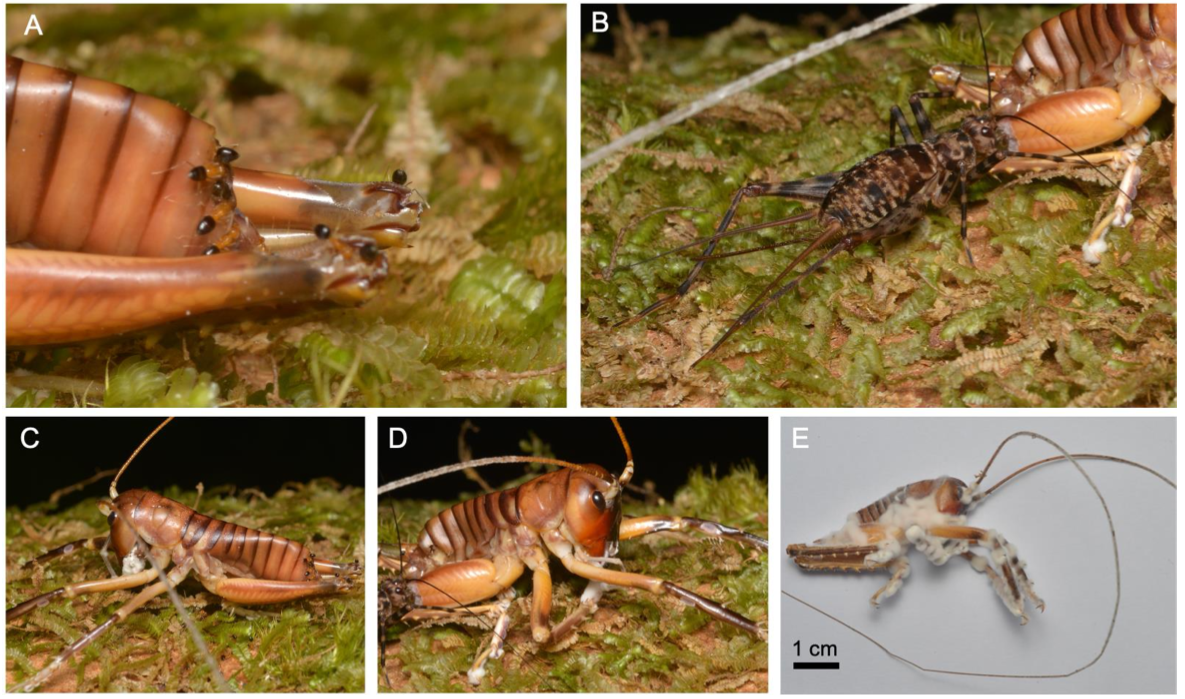
Published in bioRxiv, 2024
Chromatin Immunoprecipitation sequencing (ChIP-seq) is the method of choice to generate chromatin landscapes across genomes. The scarcity of literature on ChIPseq and absence of a canonical “gold standard” method in mollusks and especially the pacific oyster Magallana gigas, prompted us to compare four ChIP-seq methodologies (Native-ChIP, Crosslink-ChIP, ChIPmentation and Cut & Tag) to find the most suitable method for this species. Our results show that Cut & Tag performs best and ChIPmentation worst. We hypothesize that the reason for this lies in a particularly fragile chromatin structure around genes in the oyster.
Recommended citation: Dellong, A., Fallet, M., Stenger, PL., Chaparro, C., Vidal-Dupiol, J., Clément, J., Cosseau, C. & Grunau, C. (2024). Benchmarking of Chromatin Immunoprecipitation (ChIP-Seq) methods in the Pacific oyster Magallana gigas. bioRxiv, 2024-12, https://doi.org/10.1101/2024.12.28.630603 https://www.biorxiv.org/content/10.1101/2024.12.28.630603.full.pdf
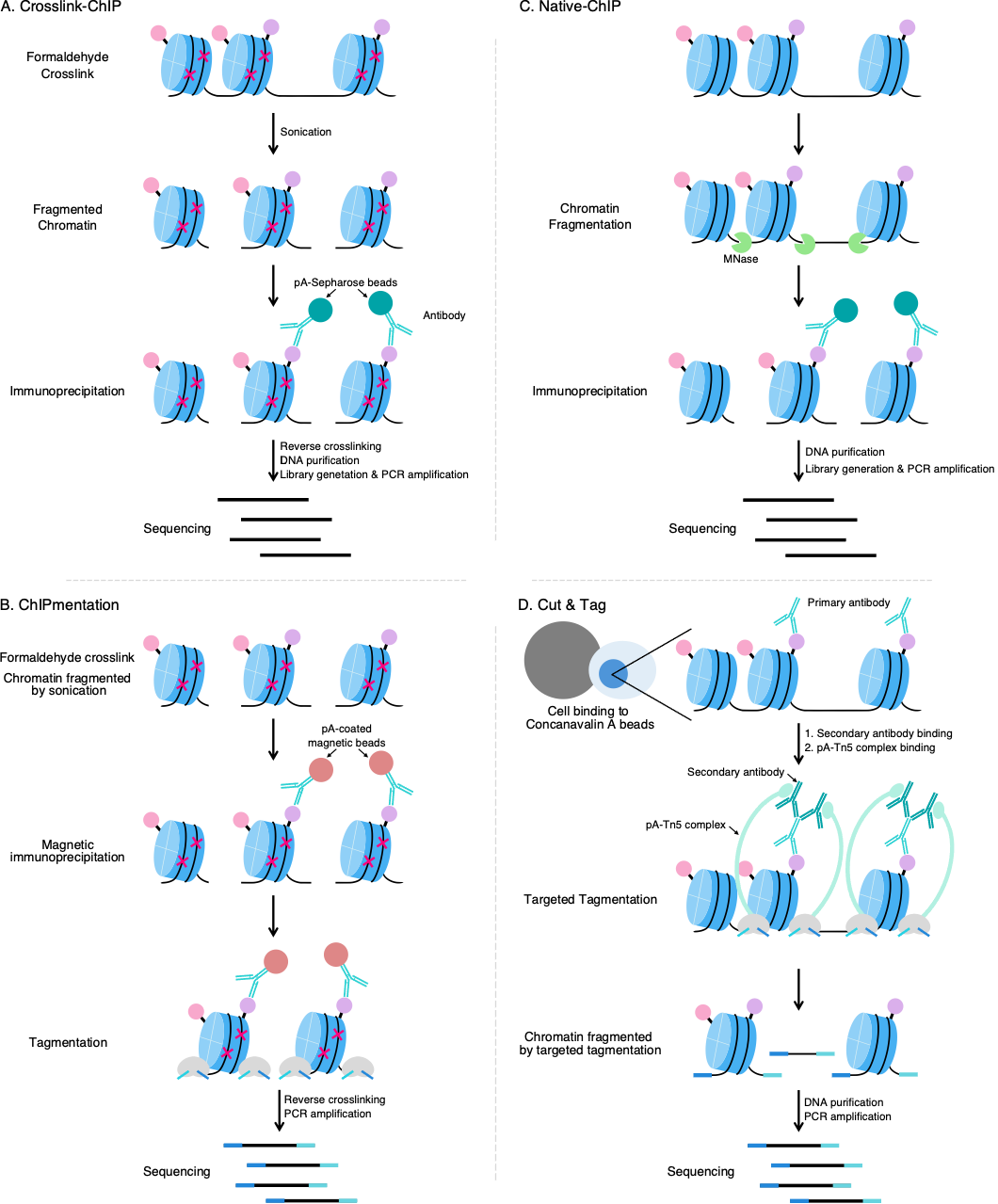
Published in PLOS ONE, 2025
Soil health and One Health are global concerns necessitating the development of refined indicators for effective monitoring. This paper introduces the Anaconda R Package, a novel tool for enhancing the analysis of eDNA data. Its application to traditional agricultural practices in Maré Island, New Caledonia, sheds light on the effects of fallow period length on microbial communities.
Recommended citation: Stenger PL., Léopold A., Dinh K., Mournet P., Robert N., Drouin J., Wamejonengo J., Russet S., Ibanez T., Maggia L., Carriconde F. (2025). Advancing biomonitoring of eDNA studies with the Anaconda R package: Integrating soil and One Health perspectives in the face of evolving traditional agriculture practices. PLOS ONE, 20(1), e0311986, https://doi.org/10.1371/journal.pone.0311986 https://doi.org/10.1371/journal.pone.0311986
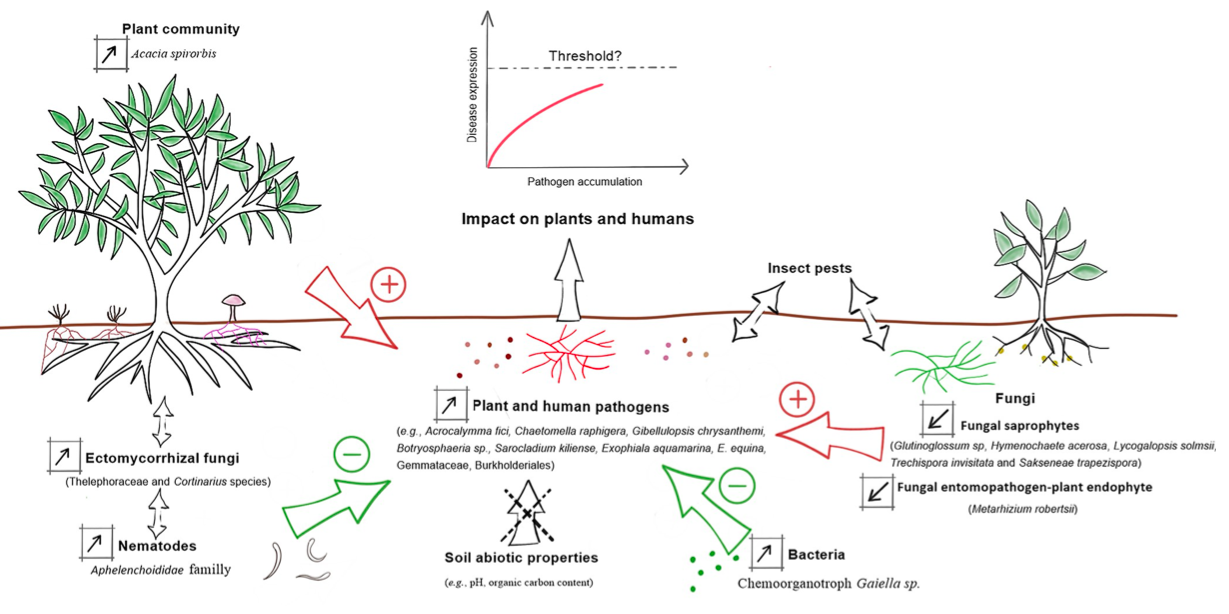
Published in Microbial Ecology, 2025
This study utilizes a multimarker DNA sequencing approach to identify microbial bioindicators in coral reef ecosystems. Focusing on La Réunion Island, the research highlights the critical roles of bacteria, fungi, microalgae, and protists in monitoring reef health and informing conservation strategies.
Recommended citation: Stenger PL., Tribollet A., Guilhaumon F., Cuet P., Pennober G., Jourand P. (2025). A Multimarker Approach to Identify Microbial Bioindicators for Coral Reef Health Monitoring: Case Study in La Réunion Island. Microbial Ecology, 87:179, https://doi.org/10.1007/s00248-025-02495-3 https://doi.org/10.1007/s00248-025-02495-3
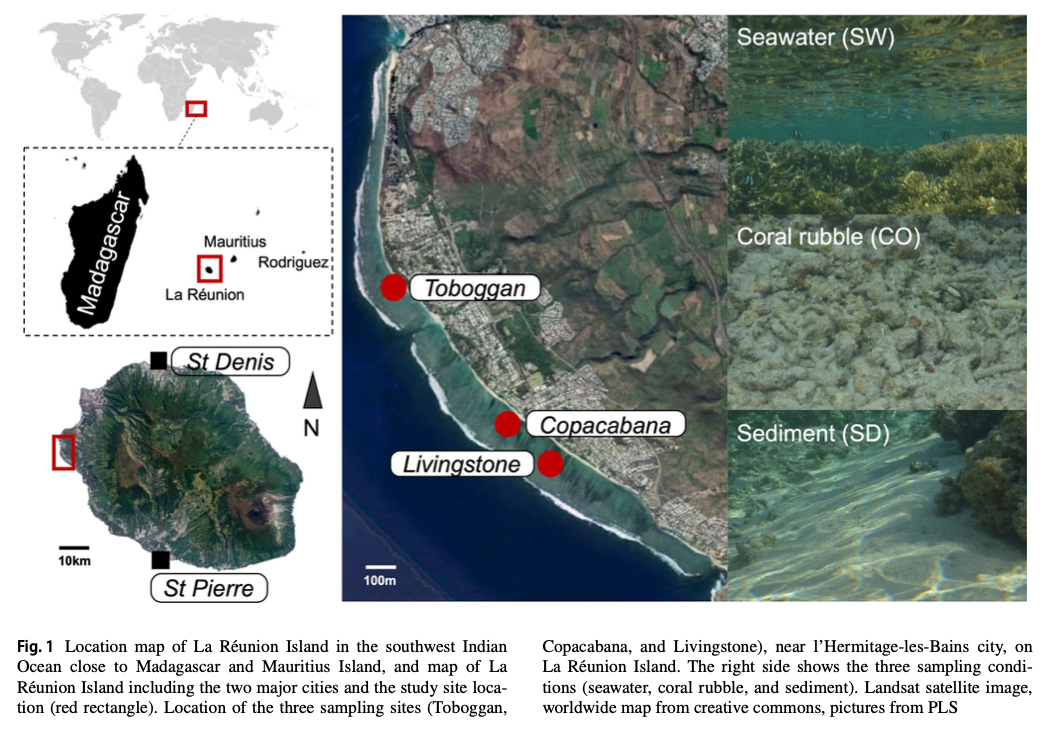
Published in Internatonal Symposium of Green Chemestry (ISGC 2015) in La Rochelle, 2052
Testing correlations between genetic diversity and chemical pollution exposure in a bioaccumalting marine bivalve (2015) Speaker: Eric Pante Authors: A. Viricel, PL Stenger, Vanessa Becquet, Eric Pante, Antoine Bonnet, Carine Churlaud, Stéphane Le Floch, Marianne Graber, Marius Pageaud, Hélène Thomas-Guyon

Published in CEPA 2015 in La Rochelle, 2052
Apport du barcoding moléculaire pour les études d’écophysioécotoxicologie. Speaker: Amelia Viricel-Pante Authors: Viricel A, Becquet V, Pante E, Stenger PL, Breitwieser M, Thomas-Guyon H.
